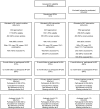The effectiveness of alcohol screening and brief intervention in emergency departments: a multicentre pragmatic cluster randomized controlled trial
- PMID: 24963731
- PMCID: PMC4070907
- DOI: 10.1371/journal.pone.0099463
The effectiveness of alcohol screening and brief intervention in emergency departments: a multicentre pragmatic cluster randomized controlled trial
Abstract
Background: Alcohol misuse is common in people attending emergency departments (EDs) and there is some evidence of efficacy of alcohol screening and brief interventions (SBI). This study investigated the effectiveness of SBI approaches of different intensities delivered by ED staff in nine typical EDs in England: the SIPS ED trial.
Methods and findings: Pragmatic multicentre cluster randomized controlled trial of SBI for hazardous and harmful drinkers presenting to ED. Nine EDs were randomized to three conditions: a patient information leaflet (PIL), 5 minutes of brief advice (BA), and referral to an alcohol health worker who provided 20 minutes of brief lifestyle counseling (BLC). The primary outcome measure was the Alcohol Use Disorders Identification Test (AUDIT) status at 6 months. Of 5899 patients aged 18 or more presenting to EDs, 3737 (63·3%) were eligible to participate and 1497 (40·1%) screened positive for hazardous or harmful drinking, of whom 1204 (80·4%) gave consent to participate in the trial. Follow up rates were 72% (n = 863) at six, and 67% (n = 810) at 12 months. There was no evidence of any differences between intervention conditions for AUDIT status or any other outcome measures at months 6 or 12 in an intention to treat analysis. At month 6, compared to the PIL group, the odds ratio of being AUDIT negative for brief advice was 1·103 (95% CI 0·328 to 3·715). The odds ratio comparing BLC to PIL was 1·247 (95% CI 0·315 to 4·939). A per protocol analysis confirmed these findings.
Conclusions: SBI is difficult to implement in typical EDs. The results do not support widespread implementation of alcohol SBI in ED beyond screening followed by simple clinical feedback and alcohol information, which is likely to be easier and less expensive to implement than more complex interventions.
Trial registration: Current Controlled Trials ISRCTN 93681536.
Conflict of interest statement
Similar articles
-
Effectiveness of screening and brief alcohol intervention in primary care (SIPS trial): pragmatic cluster randomised controlled trial.BMJ. 2013 Jan 9;346:e8501. doi: 10.1136/bmj.e8501. BMJ. 2013. PMID: 23303891 Free PMC article. Clinical Trial.
-
Effectiveness and cost-effectiveness of face-to-face and electronic brief interventions versus screening alone to reduce alcohol consumption among high-risk adolescents presenting to emergency departments: three-arm pragmatic randomized trial (SIPS Junior high risk trial).Addiction. 2022 Aug;117(8):2200-2214. doi: 10.1111/add.15884. Epub 2022 Apr 12. Addiction. 2022. PMID: 35315170 Free PMC article. Clinical Trial.
-
Screening and brief interventions for hazardous alcohol use in accident and emergency departments: a randomised controlled trial protocol.BMC Health Serv Res. 2009 Jul 3;9:114. doi: 10.1186/1472-6963-9-114. BMC Health Serv Res. 2009. PMID: 19575791 Free PMC article. Clinical Trial.
-
Screening and brief interventions for adolescent alcohol use disorders presenting through emergency departments: a research programme including two RCTs.Southampton (UK): NIHR Journals Library; 2020 Jan. Southampton (UK): NIHR Journals Library; 2020 Jan. PMID: 32011840 Free Books & Documents. Review.
-
Can screening and brief intervention lead to population-level reductions in alcohol-related harm?Addict Sci Clin Pract. 2012 Aug 28;7(1):15. doi: 10.1186/1940-0640-7-15. Addict Sci Clin Pract. 2012. PMID: 23186309 Free PMC article. Review.
Cited by
-
Evaluation of a Brief Personalised Intervention for Alcohol Consumption in College Students.PLoS One. 2015 Jun 22;10(6):e0131229. doi: 10.1371/journal.pone.0131229. eCollection 2015. PLoS One. 2015. PMID: 26098848 Free PMC article. Clinical Trial.
-
Evaluating possible intended and unintended consequences of the implementation of alcohol minimum unit pricing (MUP) in Scotland: a natural experiment protocol.BMJ Open. 2019 Jun 20;9(6):e028482. doi: 10.1136/bmjopen-2018-028482. BMJ Open. 2019. PMID: 31221890 Free PMC article.
-
The prevalence of wholly attributable alcohol conditions in the United Kingdom hospital system: a systematic review, meta-analysis and meta-regression.Addiction. 2019 Oct;114(10):1726-1737. doi: 10.1111/add.14642. Epub 2019 Jul 3. Addiction. 2019. PMID: 31269539 Free PMC article.
-
Questionable generalizability of Alcohol Use Disorders Identification Test-Consumption scoring warrants caution when used for outcome monitoring: Evidence from simulated and real-world trial data.Addiction. 2025 Sep;120(9):1825-1839. doi: 10.1111/add.70074. Epub 2025 Apr 21. Addiction. 2025. PMID: 40258803 Free PMC article.
-
Frequency of Hazardous and Binge Drinking Alcohol Among Hospitalized Cardiovascular Patients.Am J Cardiol. 2021 Aug 15;153:119-124. doi: 10.1016/j.amjcard.2021.05.026. Epub 2021 Jun 29. Am J Cardiol. 2021. PMID: 34210505 Free PMC article.
References
-
- Rehm J, Mathers C, Popova S, Thavorncharoensap M, Teerawattananon Y, et al. (2009) Global burden of disease and injury and economic cost attributable to alcohol use and alcohol-use disorders. Lancet 373: 2223–2233. - PubMed
-
- Waller S, Thom B, Harris S, Kelly M (1998) Perceptions of alcohol related attendances in accident and emergency departments in England: a national survey. Alcohol Alcohol 33(4): 354–361. - PubMed
-
- Drummond C, Phillips T, Coulton S, Barnaby B, Keating S, et al. (2005) National prevalence survey of alcohol-related attendances at accident and emergency departments in England. Alcohol Clin Exp Res 29(5): 36A (suppl).
-
- French MT, Gumus G, Turner HL (2008) The role of alcohol use in emergency department episodes. Subst Use Misuse 43: 2074–2088. - PubMed
-
- Cunningham RM, Bernstein SL, Walton M, Broderick K, Vaca FE, et al. (2009) Alcohol, tobacco, and other drugs: future directions for screening and intervention in the emergency department. Acad Emerg Med 16: 1078–1088. - PubMed
Publication types
MeSH terms
Associated data
Grants and funding
LinkOut - more resources
Full Text Sources
Other Literature Sources
Medical


